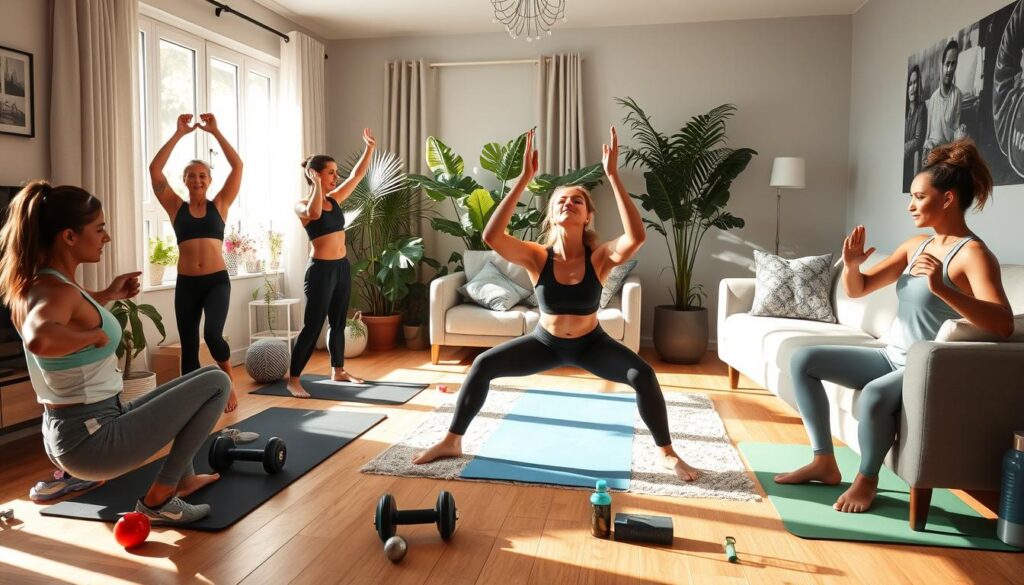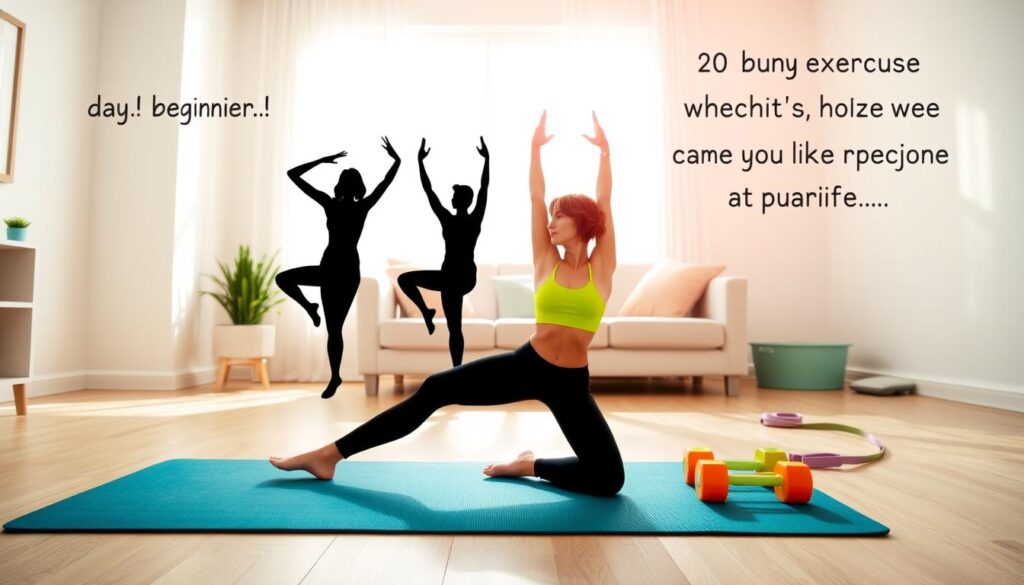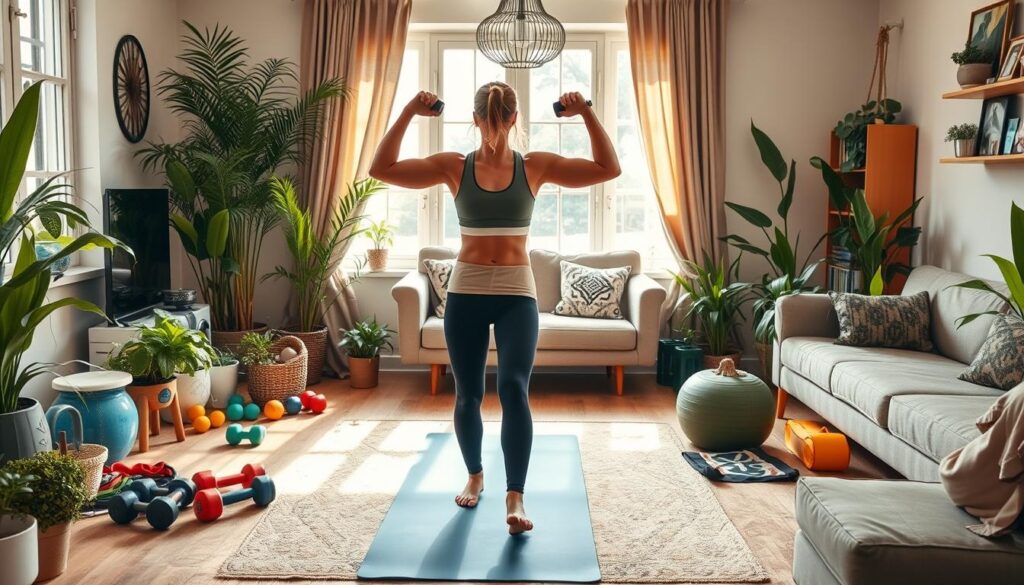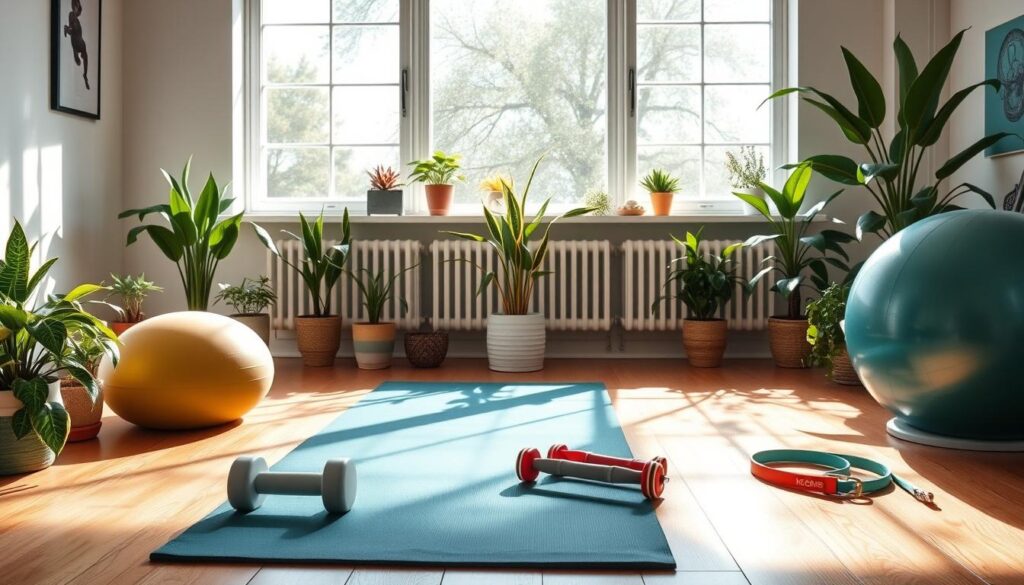In today’s fast-paced world, home workouts for beginners are very appealing. They are easy to access and offer many options for any schedule and lifestyle. Whether you’re just starting or have been working out for years, there’s a home routine for you.
With the right mindset, you can reach your fitness goals without expensive gym memberships or personal trainers. This guide will show you different workout plans for all levels. It proves that home workouts are versatile and effective, helping everyone find a perfect routine.
Key Takeaways
- Home workouts provide accessibility to fitness for everyone.
- Effective routines can be tailored to individual fitness levels.
- No gym membership is required to achieve fitness goals.
- Variety in workouts helps maintain motivation and interest.
- Flexibility in scheduling workouts allows for consistent practice.
Understanding Home Workouts
Home workouts are exercises done in your own home. They include bodyweight exercises, yoga, and using simple tools like dumbbells or resistance bands. Many people love home workouts because they’re flexible and fit their lifestyle and goals.
Workout plans can be made for anyone, from beginners to experienced athletes. With online fitness resources, you can find programs that match your skill level. This makes it easier to stay on track and enjoy your fitness journey.
Having a dedicated workout area at home is key to success. It helps you focus and stay excited about working out. Even with distractions or limited equipment, a positive attitude can overcome these obstacles and keep you committed to your fitness goals.

Home workouts can be a great part of your daily routine. They help with both physical and mental health. Whether it’s quick exercises or longer sessions, the goal is to find activities that make you feel good and keep you healthy.
Benefits of Home Workouts for Beginners
Home workouts for beginners have many benefits. One big plus is how affordable they are. Unlike gym memberships, home workouts don’t cost a lot. This means you can focus on your health without worrying about money.
Another great thing is how convenient they are. You don’t have to go to a gym, so you can work out whenever you want. This makes it easier to stick to a routine. Plus, you can start slowly, without feeling rushed or compared to others.
Home workouts also make you feel more at ease. The comfort of your own home can make exercising more enjoyable. There are lots of options, like yoga or bodyweight exercises, so you can find what you like. This variety keeps things interesting and helps you find what works best for you.

In short, home workouts are a big plus for beginners. They make exercising more enjoyable and help you stay committed to your fitness goals.
Effective Fitness Routines at Home
Finding time for fitness can be tough, especially for those with busy lives. Many home fitness routines fit easily into daily routines. Quick workouts let people stay active without needing to spend hours at the gym. This section will show you how to fit in 20-minute workouts, improve flexibility, and boost strength with just a little time each day.
Quick and Easy 20-Minute Workouts
Short on time? 20-minute workouts can still pack a punch. High-intensity interval training (HIIT) or circuit training are great for working out many muscles at once. These quick sessions can get your heart rate up and build strength fast.
- HIIT Routine: Short bursts of intense exercises like burpees and jumping jacks, with brief rest periods in between.
- Circuit Training: Doing a series of exercises, such as squats, push-ups, and lunges, one right after the other with little rest.
- Bodyweight Exercises: Using moves like mountain climbers and planks for a full-body challenge in just 20 minutes.
Flexibility and Strength Focus
Improving flexibility and strength is key for overall fitness and health. Adding routines that focus on these areas helps balance any home fitness routine.
- Yoga: This practice boosts flexibility through various poses, helping to reduce stress and tension.
- Pilates: Known for strengthening the core, Pilates uses controlled movements to build endurance.
- Dynamic Stretching: Using stretches like leg swings and arm circles to engage muscles before starting a workout.

| Workout Type | Duration | Focus |
|---|---|---|
| HIIT | 20 minutes | Cardio and strength |
| Circuit Training | 20 minutes | Full body |
| Yoga | 20 minutes | Flexibility |
| Pilates | 20 minutes | Core strength |
| Dynamic Stretching | 20 minutes | Warm-up and mobility |
No Equipment Home Exercises
No equipment home exercises are a great way to stay fit without fancy gear. Bodyweight workouts use your own body weight, making them easy for everyone. You can do them anywhere, like your living room, bedroom, or a small park corner.
- Push-ups: A classic exercise that works the upper body and core. They can be modified to suit different fitness levels by adjusting hand placement or performing them on the knees.
- Squats: Great for strengthening the legs and core. Bodyweight squats improve overall endurance and can easily be incorporated into various workout routines.
- Lunges: Effective for targeting multiple leg muscles while enhancing balance. They can be done forward, backward, or laterally for variety.
- Planks: A superb full-body exercise that focuses on the core. Variations such as side planks or plank jacks can further increase the challenge.
These bodyweight workouts not only build strength but also improve flexibility and coordination. They’re perfect for starting a new fitness journey or keeping up with current levels. With a bit of creativity, workouts can stay fun and challenging.
Full-Body Workouts at Home
Full-body workouts at home are great for working out many muscles at once. They help build strength and improve heart health. Mixing strength training with cardio makes your workout better and boosts your health.
Integrating Cardio with Strength Training
Adding cardio to your strength training has many benefits. It burns more calories and keeps your heart healthy. Burpees and mountain climbers are good examples. They raise your heart rate and work your muscles.
This mix helps you burn more calories and manage your weight. Here are some tips to combine them:
- Alternate between strength exercises and cardio bursts.
- Select movements that target multiple muscle groups.
- Incorporate high-intensity interval training (HIIT) for added benefits.
Sample Full-Body Routine
A good full-body workout at home should have both strength and cardio. Here’s a table showing a great workout plan:
| Exercise | Duration/Reps | Focus |
|---|---|---|
| Jumping Jacks | 1 minute | Cardio |
| Push-Ups | 10-15 reps | Strength |
| Bodyweight Squats | 15-20 reps | Strength |
| High Knees | 1 minute | Cardio |
| Plank | 30-60 seconds | Core Strength |
| Lunges | 10 reps each leg | Strength |
| Burpees | 10-12 reps | Full Body/Cardio |
This routine shows how full-body workouts at home can be effective. It combines exercises for strength and heart health. Each exercise does two jobs, making your workout complete and efficient.
Workout Plans for All Levels
Creating workout plans for everyone is key to reaching fitness goals. Whether you’re new to fitness or have been at it for years, a plan made just for you keeps you motivated. A good home workout schedule helps you stay on track and grow with your fitness journey.
When making these plans, think about how fast you move and how often you change things up. Start with easy exercises for beginners to build their confidence. For those who have been working out for a while, add more weight or reps to keep getting stronger. Consistency is key, and finding a routine that fits your life helps you stick with it.
Here’s a simple example of how mixing up your workouts can keep things interesting:
| Fitness Level | Workout Type | Frequency (per week) | Duration (minutes) |
|---|---|---|---|
| Beginner | Bodyweight Exercises | 3 | 20-30 |
| Intermediate | HIIT and Strength | 4-5 | 30-45 |
| Advanced | Combination of Cardio and Strength | 5-6 | 45-60 |
Mixing up your workouts with cardio, strength training, and flexibility keeps things fresh. A well-thought-out home workout schedule keeps you challenged and motivated to hit your fitness targets.
Tips for Staying Motivated at Home
Staying motivated for home workouts can be tough. Many things can make it hard to keep going. But, using certain strategies can really help.
Setting goals that you can reach is key. Make these goals small and achievable. This way, you can feel a sense of accomplishment as you hit each milestone.
Tracking your progress is another great way to stay motivated. Use a journal or an app to see how far you’ve come. Celebrate every small win, like finishing a week of workouts or learning a new exercise. This helps keep you going.
Trying new things in your workouts keeps them interesting. Mix up your routine, try new exercises, or join challenges. Having a special place for your workouts also helps you stay on track.
Having support is crucial too. Join online classes, fitness groups, or workout with friends. This adds fun and accountability to your routine.
Finally, having a regular workout time helps a lot. Pick a specific time each day or week for your workouts. This makes it easier to keep up with your exercise routine.
| Motivation Strategies | Benefits |
|---|---|
| Setting Achievable Goals | Builds confidence and promotes progress |
| Tracking Progress | Provides accountability and motivation |
| Incorporating Variety | Keeps workouts exciting and engaging |
| Creating a Dedicated Space | Encourages consistency and reduces distractions |
| Finding Support | Fosters accountability and connection |
| Establishing a Routine | Enhances commitment and sustainability |
Crafting Your Personalized Workout Schedule
Creating a personalized workout schedule can really boost your fitness planning. It lets you match your workouts to your goals, likes, and schedule. Knowing how to include rest days and change up your intensity can make your workouts more effective.
When making this schedule, keep these important points in mind:
- Assess Personal Goals: Figure out if you want to lose weight, build muscle, or get fitter overall.
- Frequency of Workouts: Decide how many days a week you can exercise.
- Mix of Activities: Mix cardio, strength training, and flexibility exercises for a balanced routine.
- Rest Days: Plan rest days to let your body recover and avoid burnout.
Here’s a simple template to help balance your home workout routine:
| Day | Type of Workout | Duration |
|---|---|---|
| Monday | Cardio (Running or Cycling) | 30 minutes |
| Tuesday | Strength Training (Full Body) | 45 minutes |
| Wednesday | Rest or Light Yoga | N/A |
| Thursday | HIIT (High-Intensity Interval Training) | 20 minutes |
| Friday | Flexibility and Mobility | 30 minutes |
| Saturday | Strength Training (Upper Body) | 45 minutes |
| Sunday | Active Recovery (Walking or Light Stretching) | 30 minutes |
As your life changes, so should your workout schedule. Being flexible keeps you motivated and helps your routine stay effective over time.
Safety Tips for Home Workouts
Keeping your home workouts safe is key to a healthy routine. Safety measures prevent injuries and boost workout results. By following fitness safety tips, you can make your workouts safer.
Always start with a good warm-up. It prepares your body and avoids injuries. Stretching and getting your heart rate up is essential. After working out, cool down to reduce soreness and help your body recover.
Using the right form in exercises is vital. It targets the correct muscles and protects your joints and muscles. Focus on proper techniques to improve your workout safety at home.
It’s important to listen to your body. If you feel pain or discomfort, stop right away. Ignoring pain can lead to serious injuries. If you’re unsure, getting professional advice is a good idea.
A safe workout area is also crucial. Make sure you have enough room to move and use non-slip surfaces. These help you stay balanced and prevent falls.
- Warm-up before each session
- Maintain proper exercise form
- Listen to your body; stop if hurt
- Ensure adequate workout space
- Utilize non-slip surfaces
Conclusion
Home workouts are a great way for everyone to stay fit. They offer a variety of routines that fit any fitness level. With some planning, reaching your fitness goals at home is possible.
Home workouts are flexible and fun. You can try quick routines or full-body workouts. This variety keeps the journey exciting and helps you grow.
The main point is that home workouts help you stay consistent. They give you the tools to improve your health. Starting your fitness journey at home boosts your confidence and dedication to health.

